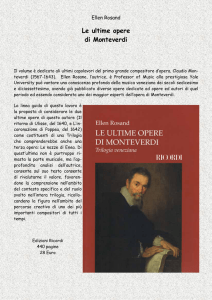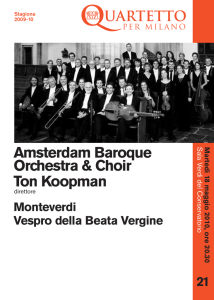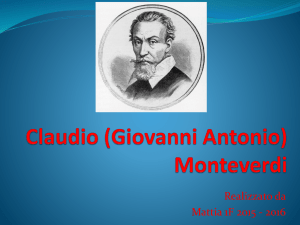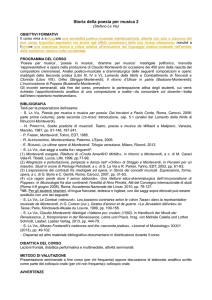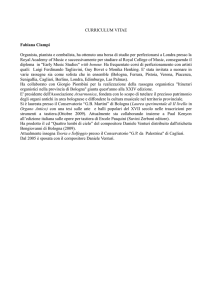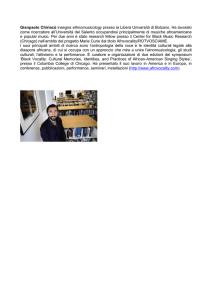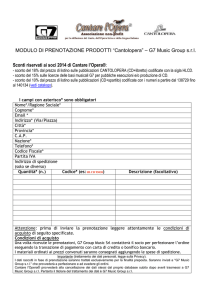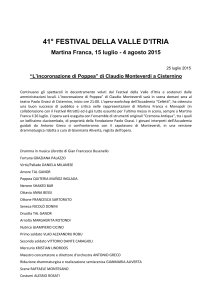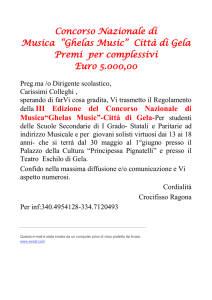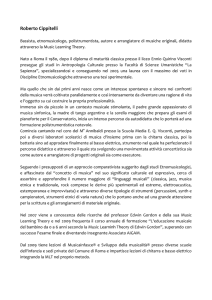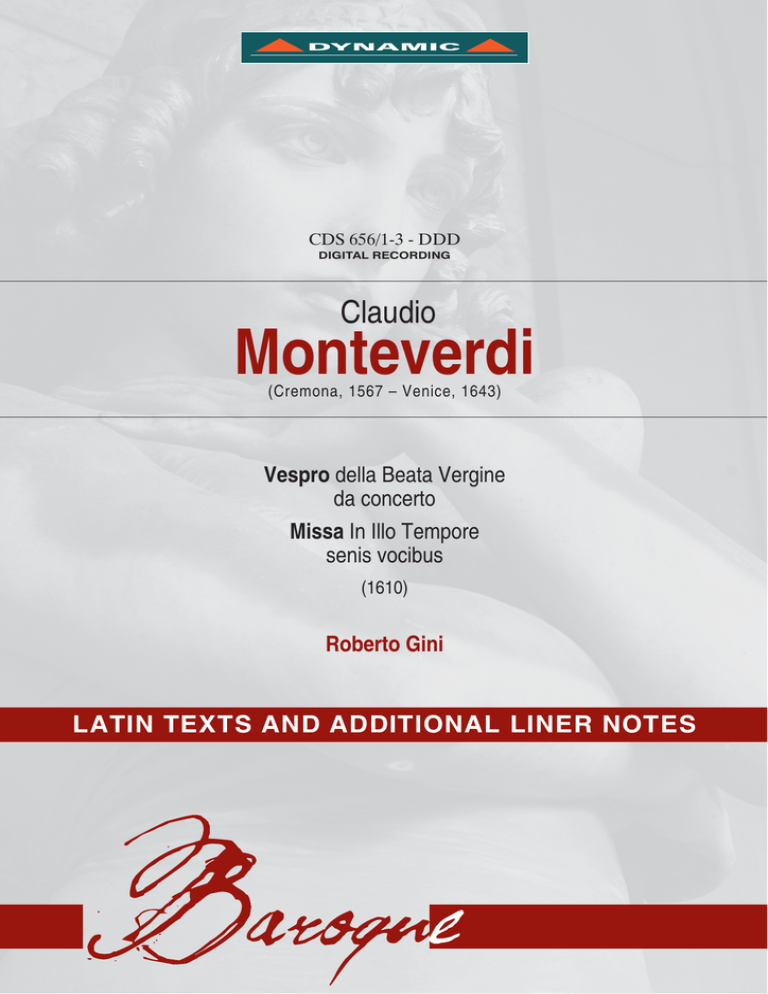
DYNAMIC
CDS 656/1-3 - DDD
DIGITAL RECORDING
Claudio
Monteverdi
(Cremona, 1567 – Venice, 1643)
Vespro della Beata Vergine
da concerto
Missa In Illo Tempore
senis vocibus
(1610)
Roberto Gini
LATIN TEXTS AND ADDITIONAL LINER NOTES
et in saecula saeculorum. Amen.
CD1
VESPRO DELLA BEATA VERGINE DA CONCERTO IN FESTO ASSUMPTIONIS
Antiphona.
Maria virgo assumpta est
ad aethereum thalamum: in quo rex regum stellato sedet
solio.
1.
V. Deus, in adiutorium meum intende.
R. Domine, ad adiuvandum me festina.
Gloria Patri et Filio, et Spiritui sancto,
sicut erat in principio, et nunc et semper,
et in saecula saeculorum. Amen. Alleluia.
5. Pulchra es.
Pulchra es, amica mea, suavis et decora filia Jerusalem, terribilis ut castrorum acies ordinata.
Averte oculos tuos a me quia ipsi me avolare fecerunt.
2. Antiphona.
Assumpta est
6. Antiphona.
Exaltata est
Psalmus 110.
Dixit Dominus Domino meo: sede a dextris meis.
Donec ponam inimicos tuos, scabellum pedum tuorum.
Virgam virtutis tuae emittet Dominus ex Sion: dominare in
medio inimicorum tuorum.
Tecum principium in die virtutis tuae
in splendoribus sanctorum: ex utero, ante luciferum, genui
te.
Iuravit Dominus et non paenitebit eum:
tu es sacerdos in aeternum secundum ordinem Melchisedech.
Dominus a dextris tuis, confregit in die irae suae reges.
Iudicabit in nationibus, implebit ruinas: conquassabit capita
in terra multorum.
De torrente in via bibet: propterea exaltabit caput.
Gloria Patri et Filio, et Spiritui sancto,
sicut erat in principio, et nunc et semper,
et in saecula saeculorum. Amen.
Psalmus 121.
Laetatus sum in his quae dicta sunt mihi: in domum Domini ibimus.
Stantes erant pedes nostri: in atriis tuis Jerusalem.
Jerusalem, quae aedificatur ut civitas: cuius participatio eius
in id ipsum.
Illuc enim ascenderunt tribus, tribus Domini: testimonium
Israel ad confitendum nomini Domini.
Quia illic sederunt sedes in iudicio: sedes super domum
David.
Rogate quae ad pacem sunt Jerusalem: et abundantia diligentibus te.
Fiat pax in virtute tua: et abundantia in turribus tuis.
Propter fratres meos et proximos meos: loquebar pacem de
te;
Propter domum Domini Dei nostri; quesivi bona tibi.
Gloria Patri et Filio, et Spiritui sancto,
sicut erat in principio, et nunc et semper,
et in saecula saeculorum. Amen.
Antiphona.
Assumpta est Maria in caelum:
gaudent Angeli, laudantes benedicunt Dominum.
Antiphona.
Exaltata est Sancta Dei genitrix super choros angelorum ad
celestia regna.
3. Nigra sum.
Nigra sum sed formosa, filiae Jerusalem.
Ideo dilexit me rex et introduxit me in cubiculm suum et
dixit mihi:
surge, amica mea, et veni.
Iam hiems transit, imber abiit et recessit,
flores aparuerunt in terra nostra.
Tempus putationis advenit.
7. Duo Seraphim.
Duo Seraphim clamabant alter ad alterum:
Sanctus Dominus Deus Sabaoth.
Plena est omnis terra gloria eius.
Tres sunt, qui testimonium dant in coelo:
Pater, Verbum et Spiritus Sanctus.
Et hi tres unum sunt.
Sanctus Dominus Deus Sabaoth.
Plena est omnis terra gloria eius.
4. Antiphona.
Maria Virgo
Psalmus 112.
Laudate pueri Dominum: laudate nomen Domini.
Sit nomen Domini benedictum,
ex hoc nunc et usque in saeculum.
A solis ortu usque ad occasum, laudabile nomen Domini.
Excelsus super omnes gentes Dominus,
et super caelos gloria eius.
Quis sicut Dominus Deus noster, qui in altis habitat,
et humilia respicit in caelo et in terra?
Suscitans a terra inopem, et de stercore erigens pauperem:
ut collocet eum cum principibus, cum principibus populi sui.
Qui habitare facit sterilem in domo, matrem filiorum laetantem.
Gloria Patri et Filio, et Spiritui sancto,
sicut erat in principio, et nunc et semper,
8. Antiphona
Post partum
Psalmus 126.
Nisi Dominus aedificaverit domum: in vanum laboraverunt
qui aedificant eam.
Nisi Dominus custodierit civitatem: frustra vigilat qui custodit eam.
Vanum est vobis ante lucem surgere: surgite postquam sederitis, qui manducatis panem doloris.
Cum dederit dilectis suis somnum: ecce haereditas Domini
filii: merces, fructus ventris.
Sicut sagittae in manu potentis: ita filii excussorum.
2
Beatus vir qui implevit desiderium suum ex ipsis:
non confundetur cum loquetur inimicis suius in porta.
Gloria Patri et Filio, et Spiritui sancto,
sicut erat in principio, et nunc et semper,
et in saecula saeculorum. Amen.
ejus quis sustinebit?
Emittet verbum suum, et liquefaciet ea: flabit spiritus ejus,
et fluent aquae.
Qui annuntiat verbum suum Jacob: justitias et judicia sua
Israel.
Non fecit taliter omni nationi: et judicia sua non manifestavit eis.
Gloria Patri et Filio, et Spiritui sancto,
sicut erat in principio, et nunc et semper,
et in saecula saeculorum. Amen.
Antiphona.
Post partum Virgo inviolata permansisti Dei genitrix intercede pro nobis.
9. Audi coelum
Audi coelum, verba mea,
plena desiderio
et perfusa gaudio.
Eco: Audio!
Dic, quaeso, mihi:
Quae est ista, quae consurgens
ut aurora rutilat
ut benedicam?
Eco: Dicam!
CD2
Dic nam ista pulchra
ut luna, electa
ut sol, replet laetitia
terras, coelos, Maria?
Eco: Maria!
Maria Virgo illa dulcis,
praedicata de propheta Ezechiel
porta orientalis?
Eco: Talis!
Illa sacra et foelix porta,
per quam mors fuit expulsa,
introducta autem vita?
Antiphona.
Paradisi portae per te nobis apertae sunt que hodie gloriosa
cum angelis triumphas.
VESPRO DELLA BEATA VERGINE DA CONCERTO IN FESTO ASSUMPTIONIS
1. Sonata.
Santa Maria ora pro nobis.
2. Capitulum (Eccl. 24, vv. 7-8).
In omnibus requiem quaesivi, et in haereditate Domini morabor. Tunc praecepit, et dixit mihi Creator omnium, et qui
creavit me, requievit in tabernaculo meo.
3. Hymnus.
Ave maris stella,
Dei mater alma,
atque semper Virgo,
Felix caeli porta.
Eco: Ita!
Quae semper tutum est medium
inter homines et Deum,
pro culpis remedium.
Eco: Medium!
Omnes hanc ergo sequamur,
qua cum gratia mereamur
vitam aeternam
consequamur.
Praestet nobis Deus
Pater hoc et Filius,
et Mater
cuius nomen invocamus dulce
miseris solamen.
Sumens illud Ave
Gabrielis ore,
Funda nos in pace,
Mutans Hevae nomen,
Solve vincla reis,
Profer lumen caecis:
Mala nostra pelle,
Bona cuncta posce.
Eco: Sequamur!
Monstra te esse matrem:
Sumat per te prences,
Qui pro nobis natus,
Tulit esse tuus.
Eco: Amen!
Benedicta es, virgo Maria,
in saeculorum saecula.
Virgo singularis,
Inter omnes mitis,
Nos culpis solutos,
Mites fac et castos.
10. Antiphona.
Paradisi
Psalmus 147.
Lauda Jerusalem Dominum: lauda Deum tuum.
Quoniam confortavit seras portarum tuarum: benedixit filiis
tuis in te.
Qui posuit fines tuos pacem: et adipe frumenti satiat te.
Qui emittit eloquium suum terrae: velociter currit sermo eius.
Qui dat nivem sicut lanam: nebulam sicut cinerem spargit.
Mittit crystallum suam sicut buccellas, ante faciem frigoris
Vitam paraesta puram,
Iter para tuum:
Ut videntes Jesum,
Semper collaetemur.
Sit laus Deo Patri,
Summo Christo decus,
Spiritui Sancto,
3
Tribus honor unus.
Amen.
pace.
R. Amen.
4. Versiculus
V. Paradisi portae per te hodie apertae sunt
R. Quae hodie gloriosa cum angelis triumphans
***
19-30. Magnificat
Magnificat anima mea Dominum ... (Re: Nn. 6-17)
5. Antiphona ad Magnificat.
Hodie Maria Virgo caelos, ascendit: gaudete, quia cum Christo regnat in aeternum.
CD3
6. Magnificat (Lc, I, 46-55).
Magnificat anima mea Dominum.
MISSA IN ILLO TEMPORE “, SENIS VOCIBUS IN FESTO SANCTAE BARBARAE
7. Et exsultavit spiritus meus,
in Deo salutari meo.
1. Introito (Ps. 44).
Gaudeamus omnes in Domino, diem festum celebrantes
sub honore beate Barbare virginis, de cuius passione gaudent angeli et collaudant filium Dei. Ps. Eructavit cor meum
verbum bonum: dico ego opera mea regi.
V. Gloria Patri et Filio, et Spiritui sancto,
sicut erat in principio, et nunc et semper,
et in saecula saeculorum. Amen.
8. Quia respexit humilitatem ancillae suae,
ecce enim ex hoc beatam me dicent omnes generationes.
9. Quia fecit mihi magna qui potens est,
et sanctum nomen eius.
10. Et misericordia eius a progenie in progenies,
timentibus eum.
2. Kyrie Christe Kyrie.
Kyrie eleison. Kyrie eleison. Kyrie eleison.
Christe eleison. Christe eleison. Christe eleison.
Kyrie eleison. Kyrie eleison. Kyrie eleison.
11. Fecit potentiam in brachio suo,
dispersit superbos mente cordis sui.
3. Gloria.
Gloria in excelsis Deo. Et in terra pax hominibus bonae voluntatis. Laudamus te. Benedicimus te. Adoramus te. Glorificamus te. Gratias agimus tibi propter magnam gloriam
tuam. Domine Deus, rex caelestis, Deus Pater omnipotens.
Domine fili unigenite Jesu Christe. Domine Deus, agnus Dei,
filius patris. Qui tollis peccata mundi, miserere nobis. Qui
tollis peccata mundi, suscipe deprecationem nostram. Qui
sedes ad dexteram patris, miserere nobis. Quoniam tu solus
sanctus. Tu solus Dominus. Tu solus altissimus, Jesu
Christe. Cum sancto Spiritu in gloria Dei Patris.
Amen.
12. Deposuit potentes de sede,
et exaltavit humiles.
13. Esurientes implevit bonis,
et divites dimisit inanes.
14. Suscepit Israel puerum suum,
recordatus misericordiae suae.
15. Sicut locutus est ad patres nostros,
Abraham et semini eius in saecula.
16. Gloria Patri et Filio, et Spiritui Sancto.
4. Graduale (Ps. 44, 5. 11).
Propter veritatem, et mansuetudinem, et iustitiam, et deducet te mirabiliter dextera tua.
V. Audi fìlia, et vide, et inclina aurem tuam et obliviscere
populum tuum, et domum patris tui.
17. Sicut erat in principio, et nunc et semper,
et in saecula saeculorum. Amen.
18. Oratio
Dominus vobiscum.
R. Et cum spiritu tuo.
Oremus.
Famulorum tuorum, quaesumus Domine, delictis ignosce:
ut qui tibi placere de actibus nostris non valemus, Genitricis Filii tui Domini nostri intercessione salvemur. Per eundem Dominum nostrum Jesum christum Filium tuum, qui
tecum vivit et regnat.in unitate Spiritus Sancti Deus, per
omnia saecula saeculorum.
R. Amen.
V. Dominus vobiscum.
R. Et cum spiritu tuo.
V. Benedicamus Domino.
R. Deo gratias.
V. Fidelium animae per misericordiam Dei requiescant in
5. Alleluia.
Alleluia.
V. Veni ad me Barbara dilecta mea: veni, et labori tuo finem
imponam, et te reficiam in eternum.
6. Sequenza.
Mater alma perge trino
numini psallens honorem
rite debitum dare.
Martyrem colens decoram
virginem lauda: colenda
laude grata est Barbara.
Illa cecis e tenebris,
editum lumen refulget
sole puro clarius.
4
Flos velut rose nitentis
e rubo fragrans, parente
nata surgit impio.
Fonte nam simul salubri
prodiit, scelus parentis
pertinacis horruit.
Pura flagravit pudico
igne, sponsi amore castum
pectus arsit intimo.
Concupivit rex decorem,
et tenelle vim puelle
addidit mirabilem.
Cesa flagris, vel capillis
rapta flavis vel papillis
nuda sectis ambulat.
Cesa perfert, nec manentem
vultus instantis tyranni
virginem minax quatit.
Quin manu caput paterna
amputante non retractat
ore, sed Jesum invocat.
Filia, sic usque serpens
Eva quo decepta mater
Concidit, fractus iacet.
Ergo nunc nitente palma
floret insignis corona
sempiterne glorie.
O beata virgo, martyr,
sponsa Christi, fac precamur
te precante, ut hec Deo sint
grata, que fiunt sacra. Amen.
Pleni sunt caeli et terra gloria tua. Hosanna in excelsis.
13. Benedictus qui venit in nomine Domini. Hosanna in excelsis.
14. Agnus Dei.
Agnus Dei, qui tollis peccata mundi, miserere nobis. Agnus
Dei, qui tollis peccata mundi, miserere nobis. Agnus dei,
qui tollis peccata mundi, dona nobis pacem.
15. Communio.
Virgo Barbara, Christi summi sponsa, ora ut nostra Deo
grata sint obsequia, que in honorem tue passionis exhibemus hodie.
16. Ite missa est.
Ite, missa est.
Deo gratias.
7. Credo.
Credo in unum Deum. Patrem omnipotentem, factorem
caeli et terrae, visibilium omnium et invisibilium. Et in
unum Dominum Jesum Christum Filium Dei unigenitum. Et
ex Patre natum ante omnia saecula. Deum de Deo, lumen
de lumine, Deum verum de Deo vero. Genitum, non factum,
consubstantialem Patri, per quem omnia facta sunt. Qui
propter nos homines, et propter nostram salutem descendit
de caelis.
8. Et incarnatus est de Spiritu Sancto ex Maria Virgine, et
homo factus est.
9. Crucifixus etiam pro nobis, sub Pontio Pilato passus et
sepultus est. Et resurrexit tertia die secundum scripturas. Et
ascendit in caelum, sedet ad dexteram Patris.
10. Et iterum venturus est cum gloria iudicare vivos et mortuos, cuius regni non erit finis. Et in Spiritum sanctum Dominum et vivificantem; qui ex Patre filioque procedit. Qui
cum Patre et Filio simul adoratur et conglorificatur: qui locutus est per prophetas. Et unam, sanctam, catholicam et
apostolicam Ecclesiam. Confiteor unum baptisma in remissionem peccatorum. Et expecto resurrectionem mortuorum.
Et vitam venturi saeculi. Amen.
11. Offertorio.
Gloriosam mortem, magis quam odibilem vitam, complectens beata Barbara, voluntarie ivit ad supplicium, ibique
corpus suum impollutum obtulit Domino in sacrificium
suavis odoris.
12. Sanctus.
Sanctus, Sanctus, Sanctus, Dominus Deus Sabaoth.
5
Dei tempi metronomici e dei toni
A chiunque ascolti la sinfonia K 550 di Mozart nella registrazione diretta da Bruno Walter (1959) e in quella diretta da Frans Brüggen (1985) non sfugge, nell’accostamento, la notevole diversità dei tempi di metronomo
scelti dai due direttori.
In ogni espressione artistica si riflettono le circostanze storiche e culturali della sua epoca, e ogni epoca storica
rispecchia una sua mentalità, un gusto, un modo di vivere o una corrente culturale: un insieme di fattori che
determinano l’estetica interpretativa musicale, influenzata questa anche dalle conoscenze stilistiche acquisite
fino a quel momento.
Tra gli anni ‘50 e i ‘90 del XX secolo ha avuto luogo quell’importante corrente definita musica antica che ha
mutato la prassi esecutiva delle musiche del passato. Senza soffermarci su un’analisi del fenomeno, è chiaro
che le nuove conoscenze hanno portato ad una diversa lettura del repertorio fino ad allora eseguito su strumenti
moderni, proponendo nell’esecuzione su strumenti originali tempi molto diversi, generalmente più agili rispetto
a quelli risultanti da un’idea del suono e da tecniche strumentali tipiche della prima metà del secolo. Se nel repertorio settecentesco le variazioni di tempo possono essere tanto notevoli quanto negli esempi citati, in quello
precedente questo avviene molto relativamente perché il Tempo si fonda su un sistema che lascia molto meno
libertà agli arbitrî dell’esecutore.
Già dalla fine del ‘400 la pulsazione metronomica (Tactus) si stabilisce su un battito del polso che non ha avuto
nella fisiologia umana variazioni di rilievo. E’ su questa pulsazione che viene organizzato il sistema delle mensure
e delle proporzioni (prolazioni) i cui segni vanno intesi - per l’epoca di Monteverdi - come valori di scansione
precisi. Questi segni, pur se non più e non solo fondati sulle proporzioni aritmetiche assolute dell’epoca precedente, sono soggetti ad una certa gradualità delle scansioni temporali a seconda delle mensure impiegate dagli
autori in correlazione all’affetto, all’espressione, alla solennità proprie del brano: Girolamo Frescobaldi1
scrive infatti: ”…nelle trippole, o sesquialtere, se saranno maggiori, si portino adagio, se minori alquanto più allegre,
se di tre semiminime, più allegre, se saranno sei per quattro si dia il lor tempo con far camminare la battuta allegra”
A partire approssimativamente da metà ‘600 le indicazioni di tempo si codificano sempre più nei nomi delle
danze o si identificano nelle più flessibili diciture di Allegro Andante Adagio ecc.; sono meno soggetti ai soli
segni di prolazione e lasciano all’interprete una certa elasticità nella scelta del Tempo.
Se nel repertorio più comunemente conosciuto è quindi facile avvedersi di un’incongruenza qualora un Andante
venisse eseguito come un Presto o un Allegro come un Adagio, nella musica dell’epoca di Monteverdi ciò è
meno evidente poiché sia il pubblico sia gli stessi interpreti sono tutt’ora influenzati da esecuzioni che, a causa
di nostra ingenuità di interpreti, di convenienza o di errori di trascrizione, sono, per prassi generalizzata, diventata ormai tradizione, irriguardose delle proporzioni indicate dal compositore.
Il risultato, pur distante dall’idea del compositore, appare tuttavia all’ascoltatore di oggi ugualmente plausibile
nonché accattivante e seducente per l’evocazione frequente di suggestioni popolaresche o etniche, più vicine al
nostro gusto moderno che non all’autentico significato della composizione. Ciò si nota maggiormente nei tempi
ternari ma si risconta talvolta anche nei ritmi binari, dove accade che si aggiungano cambi di tempi non indicati
dall’autore, alterando il testo originale. Per questo motivo le proporzioni dei tempi possono sembrare oggi
troppo lente, in contrasto con la sensibilità del nostro tempo che è contraddistinta da un generico senso di frenesia che ci induce facilmente a voler riconoscere in ogni tempo ternario un brillante ritmo di danza.
Questa premessa è necessaria nella presentazione di questa registrazione poichè il Vespro della Beata Vergine,
ancorché appartenente al repertorio più antico, è un’opera molto eseguita: attenersi alle proporzioni meticolosamente indicate da Monteverdi (meticolosità testimoniata da Giovanni Battista Doni2) porta ad una esecuzione
sorprendentemente diversa da ciò che tradizionalmente viene proposto. Potrebbe addirittura sembrare una personale arbitraria rilettura del testo originale o suscitare lo stesso perplesso stupore che si prova quando i restauri
di molti capolavori pittorici del passato, rimuovendo le secolari incrostazioni che alteravano colori e forme originali, svelano talvolta un’opera d’arte affatto diversa da quella che la storia dell’arte aveva fino a quel momento
analizzato e spiegato poiché basata su un’estetica sfalsata e lontana da ciò che gli artisti volevano effettivamente
esprimere: molte teorie estetiche e filologiche si sono rivelate improvvisamente fondate su un equivoco di fondo.
Se dunque nel corso della storia dell’interpretazione musicale il tempo metronomico del repertorio più recente
è stato soggetto di variazioni anche molto evidenti, nel repertorio più antico l’interprete è tenuto ad osservare
delle indicazioni niente affatto variabili e che lasciano, nella scelta del tempo di esecuzione, assai minore flessi6
bilità in quanto segni precisi della scelta operata dal compositore.
Composizioni di musica sacra quali il Vespro della Beata Vergine sono in primo luogo espressione di preghiera,
di devozione e di introspezione, ma non si devono ignorare i due determinanti aspetti che ci possono far comprendere l’indicazione di quei tempi lenti. Il primo sta nella solennità dei brani: solennità liturgica, solennità testuale e drammatica del testo dei salmi e degli inni, solennità rappresentativa della Chiesa come istituzione e
solennità della Parola.
Il secondo aspetto sta nella considerazione dei luoghi in cui era previsto che queste musiche fossero ascoltate.
I grandi spazi e le acustiche risonanti richiedono una scansione, tanto nel parlato quanto nel canto, affatto diversa da quella che si applica in spazi più piccoli e usuali. Così come la pronuncia dell’attore in teatro deve ricorrere ad un appoggio delle sillabe e della voce stessa per consentire al suono, non amplificato artificialmente,
di correre ed essere ascoltato in tutto il teatro - un modo di parlare diverso da quello quotidiano, quasi innaturale
– così l’orazione del celebrante in una chiesa, perché sia compresa anch’essa senza l’ausilio di un’amplificazione
artificiale, deve essere molto scandita e chiara, quindi anche più lenta. Allo stesso modo, in un’acustica di chiesa,
anche la parola cantata necessita di un tempo appropriato all’acustica e al carattere sacro del testo perché non
solo sia intesa ma perché abbia il tempo di imprimere nell’animo di chi ascolta il sentimento che la musica vuole
sollecitare3. La Retorica diventa quindi il mezzo più efficace per rappresentare, persuadere, comunicare e colorare
tanto il testo parlato quanto il canto. I gesti sono enfatici, i colori della voce molto contrastati e i tempi dilatati.
Così è sempre stato dall’antichità, fintantoché la tecnologia non ha prodotto un sistema più moderno che della
Retorica ha preso il posto. E’ però sufficiente riascoltare le registrazioni più antiche dei vecchi attori di teatro,
oppure rivedere le rare testimonianze filmate di celebrazioni, liturgie e discorsi delle epoche passate, per percepire
quanto sia distante dalla nostra sensibilità il modo stesso di parlare e la maniera di gestire, e per capire che
anche la musica del passato nasce in un contesto di Retorica e di Enfasi che noi musicisti dobbiamo tenere in
indispensabile considerazione.
Si aggiunga a ciò l’annosa questione della trasposizione delle musiche scritte nelle “chiavi acute” (chiavette)
che, se non applicata dall’interprete, porta a esecuzioni di gran parte del repertorio antico fondate su un errore
di lettura, fuori tono: i soprani cantano in coloratura, i tenori spingono negli acuti diventando contralti, i bassi
sono tenori e tutto il brano viene cantato e suonato una quarta o una quinta sopra il tono previsto dall’autore.
Sarebbe come se la 9a sinfonia di Beethoven fosse eseguita una quarta sopra, da re minore a sol minore. Nella
raccolta del 1610, la Messa “In illo tempore”, il Lauda Jerusalem e entrambi i Magnificat richiedono infatti di
essere abbassati di una quarta, secondo una pratica ben codificata e indicata da tutti i trattati dell’epoca4 .
1
Dagli avvertimenti “A gli Studiosi dell’ Opera”, in “Il Primo Libro di Capricci fatti sopra diversi soggetti, et Arie in partitura…”. Roma, 1624
Quanto al Monteverdi, pare che più di amendue cerchi le durezze nel Contrapunto, e le sue modulazioni vadano cantate con quei tempi
che sono segnate.” (Lyra barberina, De’ trattati di musica pag. 128)
3
“Mi sono affaticato che le parole siano così bene disposte sotto alle note, che oltre al farle profferir bene, & tutte con intiera, & continuata
sentenza possino essere chiaramente intese da gli Uditori, pur che spiegatamente vengano proferite dai Cantori” (Ludovico Viadana, Cento
Concerti Ecclesiastici; Venezia 1602)
4
Cfr Andrew Parrott, “Transposition in Monteverdi’s Vespers af 1610. An ’aberration’ defended (in Early Music, November 1984).
2
7
L’ornamentazione
Anche l’arte dell’ornamentazione appartiene al mondo espressivo della Retorica ed è soggetta alle sue regole.
La musica contenuta nei trattati di ornamentazione rappresenta il loro vero patrimonio. Ornamenti fantasiosi,
disegni melodici, vere e proprie composizioni create per ornare i frammenti melodici standard, i soggetti riconoscibili nei brani che eseguiamo e riscontrabili, identici, in quei trattati. E’ dunque un errore il considerare i trattati
cinque e secenteschi come testi teorici, perché così facendo ci precludiamo la conoscenza e il godimento della
grande quantità di bella musica in essi contenuti e destinata a noi esecutori. Come avviene nei testi di architettura, dove i fregi e le decorazioni ivi stampate sono modelli destinati a decorare, ad esempio, le porte e le finestre
degli edifici: soggetti, queste, che senza ornamenti sono semplici e funzionali varchi aperti nelle pareti.
Le porte e le finestre nella musica sono quelle frasi a note lunghe che, da sole, non ambiscono a esprimere il sentimento delle parole ma attendono, perché acquistino significato, che l’interprete apponga loro i necessari ornamenti. Un esempio fra tanti: Audi - Ascolta (“ascolta la mia voce, il mio canto che ti invoca”), Coelum - Cielo
(l’ornamento dipinge agli occhi di chi ascolta il cielo contemplato dall’io orante), Verba mea - Le mie parole
(espressione qui intesa come parola cantata, il mio canto).
Le parole dei mottetti vogliono essere illustrate per poter diventare vere immagini: per mezzo dell’ornamento,
queste immagini possono ora evocare e rappresentare le forme e i colori che la parola significa, ora enfatizzare
l’espressione stessa del canto e della voce.
Le ornamentazioni presenti in questa registrazione sono opera di musicisti contemporanei di Monteverdi (Richardo e Francesco Rognoni, Giovanni Battista Bovicelli, Bartolomeo Barbarino, Antonio Brunelli), musiche
create per ornare soggetti “tipici”, come quelli che si trovano nel Vespro. La loro applicazione riserva sorprese
stupefacenti e potrebbe rendere le interpretazioni di oggi come quelle di allora molto personali e diversificate,
mai uguali o tra loro somiglianti.
Il Vespro della Beata Vergine come opera d’arte figurativa
La musica è serva dell’orazione. Vi è però una differenza sostanziale tra la musica profana e la musica sacra:
nella prima i testi musicati sono svariati e sempre nuovi, creati dai poeti a espressione dell’infinita varietà degli
affetti umani attraverso le parole che la musica raffigura; nella seconda il testo sacro è immutabile (messa, salmi,
magnificat) o ricorrente (mottetti, inni) e non necessariamente ricerca l’espressione dell’affetto nel singolo vocabolo.
Io ritengo che il Vespro della Beata Vergine sia un’opera d’arte figurativa. Nei salmi viene ricercata una rappresentazione teatralizzata della Parola e con essa la particolare immagine di Dio che il testo, potenziato dalla musica, evoca. Come un pittore Monteverdi illustra il sentimento di un dio qui potente e vendicativo (Dixit
Dominus) e qui dolce e affettuoso (Laudate pueri). La sua musica ci fa sentire la voce stessa di un dio ora autoritario ora addirittura “materno” e misericordioso, oppure, nel salmo Laetatus sum, infonde un sentimento di
pace profonda (il vocabolo pax vi è ricorrente) fin dal famoso inizio di semiminime nel Basso Continuo che dipinge il pellegrino al termine del suo viaggio, quando arresta il suo passo moderato davanti alle grandiose mura
di una Gerusalemme idealizzata. Sembra quasi che questa musica, che è poi l’anima del vero Barocco musicale,
diventi non solo pittura ma anche scultura sotto le mani di Monteverdi; egli conferisce ai suoni e al canto forme
a tre dimensioni, flessuose e avvolgenti, duttili e colorate. Nei due salmi Nisi Dominus e Lauda Jerusalem, invece,
la coralità degli ammonimenti e dei consigli del primo nonché l’esaltazione delle opere di dio del secondo, sono
rappresentazione della coralità delle voci che, rispondendosi, celebrano unanimemente la grandezza di una divinità luminosa. Le stesse voci che invocano una “Sancta Maria” rilucente nella Sonata, che si può a pieno titolo
definire una meravigliosa opera di architettura barocca.
La parola e la voce di Dio descritte attraverso la musica erano allo stesso tempo voce e immagine della Chiesa:
la medesima illustrazione di quei caratteri tanto diversi tra loro infondeva nei fedeli che ascoltavano il sentimento
di timore reverenziale per un’istituzione maestosa e allo stesso tempo autoritaria (Domine ad adiuvandum, Nisi
Dominus, Magnificat) ma anche l’immagine di una chiesa materna che riscatta l’inane dalla miseria (de stercore)
innalzandolo al rango di Principe o che lo culla nel calore delle proprie braccia, come farebbe una madre affettuosa
di cui Maria diventa la personificazione. Il tempo di sesquialtera maggiore che Monteverdi prescrive nel salmo
Laudate pueri, là dove il testo dice “Qui abitare facit sterilem in domo matrem filiorum lætantem”, è in questo
8
senso l’esempio di personificazione più straordinario, nonché il punto in cui maggiormente si nota la scioccante
differenza rispetto ad un’esecuzione fatta a tempo di danza: è infatti l’immagine nitida di una madre che culla
il proprio figlio cantandogli una dolce ninna nanna, qui espressa attraverso il canto di otto voci. Nei brani mariani
(Audi coelum, Ave Maris Stella) così come nei mottetti, questa umanizzazione è chiarissima e incredibilmente
seducente. Nel Nigra sum, in particolare, è stupefacente quanto i due caratteri, quello di fanciulla intimidita e
innamorata ma sicura della sua bellezza, e quello di un uomo focoso e traboccante di desiderio per lei, siano
così precisamente espressi attraverso l’umanizzazione del canto di una voce sola: una storia d’amore consumata
nell’arco di tre minuti di vero teatro in musica. Vengono alla mente le parole di Ludovico Zacconi che aveva
molto ben compreso la tendenza al “realismo” che in chiesa diventava persino imbarazzante: “… hoggi giorno
molti cantori si compiacciono di cantar soli Quam pulchra es amica mea, quam pulchra es. Tota pulchra es amica
mea, formosa mea. Fulcite me Floribus quia amore langueo con altre cose, che Dio sà con qual animo & intenzione
loro le cantano. Questo sia detto per zelo di Dio, e per avertire i cantori, che cantando nelle Chiese, si ricordino di
cantare à lode del Signore, e non à sodisfattione delle loro passioni amorose”5.
Ascoltando poi Audi coelum si evidenzia in modo chiaro l’esperienza che Monteverdi aveva già maturato nel V°
atto di Orfeo: l’analogia tra l’io orante del mottetto e il canto di Orfeo, ci mostra il Vespro del 1610 come fosse
un secondo elemento complementare alla Favola in Musica del 1607: due opere unite in un unico progetto di
drammaturgia. La musica si colloca a mio avviso alla stessa stregua delle arti figurative diventando, oltre che
autentica scena teatrale, pittura, scultura e architettura al tempo stesso.
Per l’interprete-esecutore la chiave per interpretare queste musiche non è da ricercare nella sola partitura bensì
nell’approfondimento del significato del testo sacro, e del concetto che esso deve imprimere nel cuore dell’ascoltatore. Aggiungo che similmente a quanto avviene in teatro per gli attori, dobbiamo letteralmente “entrare nel
personaggio”, sentire quei sentimenti di devozione, timore, rispetto, amore e autorità che, a prescindere dalle
soggettive opinioni e dalle nostre personali ideologie, sono l’elemento scatenante dell’espressione di questo
genere di musica autenticamente “rappresentativa”.
Questo era sicuramente l’approccio dei maestri di cappella di allora e deve essere il nostro, in quanto rappresenta
il mezzo più efficace per comprendere e interpretare, ad esempio, molte scelte di tempo operate da Monteverdi
e dai suoi contemporanei che a noi possono sembrare incomprensibili.
Roberto Gini
(un ringraziamento particolare al prof. Diego Fratelli)
5
in “Prattica di Musica, Seconda parte”; Venezia 1622 (pagg. 53-54)
9
Metronome times and tones
Anyone who listens to the symphony K 550 by Mozart in the recording conducted by Bruno Walter (1959)
and in the one conducted by Frans Brüggen (1985) will be struck by the remarkable difference in metronome
times chosen by the two conductors.
Every artistic expression reflects the historical and cultural circumstances of its epoch, and every historical epoch
reflects a mentality, taste, lifestyle or cultural movement of its own: a collection of factors which determine the
aesthetics of musical interpretation, influenced in turn by the stylistic knowledge thus far acquired.
The period between the 1950s and 1990s brought that important movement defined early music which transformed the manner of performing music of the past. Though we do not intend to dwell on an analysis of this
phenomenon, it is clear that new knowledge led to a different reading of the repertoire which until then had
been performed on modern instruments, proposing very different tempi for performance on original instruments,
tempi that are generally more agile than the ideas of sound and of typical instrumental techniques of the first
half of the twentieth century. In eighteenth-century repertoire variations of tempo can be as marked as in the
examples given above, but in the preceding repertoire this happens to a far lesser degree, as the Tempo is based
on a system which leaves much less room for the performer’s discretion.
By the end of the fifteenth century a metronomic pulse (Tactus) was already set on a pulse beat which has had
no significant variation in human physiology. This pulse beat was the basis for a system of mensurations and
of the proportions (prolations) whose signs are to be seen – in Monteverdi’s age – as very precise scansion
values. These signs, though no longer and not merely founded on the absolute arithmetical proportions of the
previous age are subject to a certain graduality of time scansions according to the “mensurations” used by
composers to match the feeling, expression or solemnity of their works. Girolamo Frescobaldi writes1: “… in
the triples or sesquialtera, if these be greater then let them be conducted slowly (adagio), if they be lesser then somewhat more briskly (allegro), if they be in three crotchets, more briskly, if they be in six fourths let their tempo be given
so as to have the beat move merrily.”
From about the middle of the seventeenth century, the tempi came increasingly to be identified with the names
of dances, now in the more flexible indications of Allegro, Andante, Adagio etc; these are less subject to prolation
signs and leave the performer a certain elasticity in the choice of Tempo.
In the better-known repertoire we can thus easily identify incongruence when an Andante is performed as a
Presto, or an Allegro as an Adagio. In Monteverdi’s music, however, this is less obvious since audiences and
performers alike are still influenced by recordings which, through common usage that has now become tradition,
do not respect the proportions indicated by the composer, on account of our ingenuousness, convenience or
errors in transcription.
The result, though it may be far from the composer’s idea, often sounds to today’s listener no less plausible or
charming and attractive in evoking popular and ethnic suggestions, closer to our modern taste but which have
little to do with the composition. This is found most clearly in triple times but is also encountered in some
binary rhythms, where changes of tempo are added that are not indicated by the author, which radically alter
the original text. This is why the proportions of the tempi may sound too slow to our ears, in contrast with the
mentality of our time, which is distinguished by a generic sense of frenzy that can easily lead us to seek a
brilliant dance rhythm in every ternary time.
This observation is necessary in the presentation of this recording since the Vespers for the Blessed Virgin, though
belonging to the more ancient repertoire, is a frequently performed work: adhering to the proportions that Monteverdi indicates meticulously (meticulousness witnessed by Giovanni Battista Doni2) leads to a performance
that is surprisingly different from what is traditionally proposed. It might even seem to the listener’s ear to be
a free, personal re-interpretation of the original text and could provoke the same perplexity as we feel with the
restoration of masterpieces of painting of the past when the removal of century-old incrustations that altered
the original colours reveals a work of art quite different from what had thus far been interpreted and explained
on the basis of distorted aesthetics far removed from the artist’s expressive intent: many aesthetic and philological theories are suddenly found to be based on a fundamental misunderstanding. Throughout the history of
music performance the metronome tempo of the more recent repertoire has been subject to variations, some
very evident, but in the more ancient repertoire the performer is obliged to observe indications that are not
variable at all and which leave far less flexibility in the choice of performance tempo given the precise signs of
10
the choices made by the composer.
Sacred compositions like the Vespers of the Blessed Virgin are first and foremost expressions of prayer, devotion
and introspection, but we must not overlook the two decisive aspects which help us to understand the indication of the slow tempi. The first is the solemnity of the pieces: liturgical, textual and dramatic solemnity of
the texts of the psalms and hymns, solemnity representing the Church as an institution and solemnity of the
Word. Just as the pronunciation of an actor in the theatre makes use of support of the syllables and of the voice
itself so that the sound, when it is not artificially amplified, can carry and be heard throughout the theatre – a
manner of speaking that is different from everyday speech, almost unnatural – thus the oration of a celebrant
in church, again if it is to be heard without the assistance of artificial amplification, must be clear and well
marked, and therefore also slower. In the same way, in the acoustics of a church, the sung word too requires a
tempo that is appropriate to the acoustic context and to the sacred character of the text not only so that it
may be heard but also so that it may have the time to impress on the listener’s soul the sentiment that the
music seeks to provoke3. Rhetoric thus becomes the most efficient means to represent, persuade, communicate
and colour both the spoken text and the song. Gestures are emphatic, the colours of the voice highly contrasting
and the tempi extended. It was always so in earlier times, until technology produced a more modern system
which has replaced rhetoric. We need only listen again to the older recordings of old theatre actors, or look at
the rare films of celebrations, liturgies and speeches of past ages, to understand just how far removed from our
sensibility is the way of speaking and the use of gesture, and to understand too that the music of the past was
born in a context of Rhetoric and Emphasis which we musicians must necessarily take into consideration.
We may add the age-old question of transposition of musical works written in the high clefs which, if it is not
applied by the performer, leads to performances of much of the early-music repertoire that are based on a mistaken reading and are out of tune: the sopranos sing coloratura, the tenors push the high notes and become
contraltos, the basses are tenors, and the whole piece is played and sung a fourth or a fifth above the tone
which the composer intended. It is as though Beethoven’s Ninth Symphony were played a fourth higher, shifted
from D minor to G minor. In the 1610 collection, the Mass In illo tempore, the Lauda Jerusalem and the two
Magnificats, in fact, need to be transposed down a fourth compared to the notes indicated in the score, in line
with a practice codified and indicated in all the treatises of the age4.
Ornamentation
The art of ornamentation likewise belongs to the expressive world of Rhetoric and is subject to its rules. The
music contained in ornamentation treatises represents its true heritage. Fanciful ornaments, melodic patterns,
compositions created to embellish “standard” melodic fragments, that is to say those subjects that can be recognised in all the pieces we perform and can be found, identical, in the treatises. It is a mistake to consider sixteenth
and seventeenth-century treatises as theoretic works, for this precludes knowledge and enjoyment of the great
quality of fine music they contain for us performers. This is what happens in architecture treatises, where the
friezes and decorations printed are models destined to decorate, for example, doors and windows of bare buildings: subjects which, without the ornaments, are simply functional, repetitive openings in the walls.
The doors and windows in music are the long notes which alone do not seek to express the feeling of the words
but wait, to acquire meaning, for the performer to apply the necessary ornaments. One example among many:
Audi – Listen (“Listen to my voice, my song that invokes you”), Coelum – Heaven (the ornament depicts in the
eyes of the listener the heaven contemplated by the praying voice), Verba Mea – My words (an expression which
here means the sung word, my song).
The words of the motets wish to be illustrated in order to become real images: through the use of ornaments,
these images can now evoke and represent the forms and the colours signified by the word and amplify the
very expression of the song and the voice.
The ornamentations present in this recording are the work of musicians of Monteverdi’s time (Richardo and
Francesco Rognoni, Giovanni Battista Bovicelli, Bartolomeo Barbarino, Antonio Brunelli), music created to decorate
“typical” subjects, like those found in the Vespers. Their application brings astonishing surprises and might make
today’s performances, like those of the past, very personal and diversified, never the same and like one another.
11
The Vespers of the Blessed Virgin as a work of figurative art
Music is the handmaiden of oration. There is, however, a substantial difference between profane and sacred
music: in the former, the texts are various and always new, created by poets to express the infinite variety of
human feelings through the words that the music depicts; in the latter, the sacred text is unchanging (mass,
psalms, magnificat) or recurrent (motets, hymns) and not necessarily a search for the expression of the mood
of every single word.
I believe that the Vespers of the Blessed Virgin is a work of figurative art. The psalms seek a representation of
the Word and with this the particular image of God evoked by the text reinforced by the music. Like a painter
Monteverdi illustrates the sentiment now of a mighty, vindictive god (Dixit Dominus), now of a sweet, affectionate god (Laudate pueri). His music lets us hear the voice of a god who is in turn authoritarian, then even
“maternal” and merciful, or, in the psalm Laetatus sum, it infuses a profound sense of peace (the word pax is recurrent) from the famous opening in crotchets of the basso continuo which depicts the pilgrim at the end of
his journey, when his slow step halts before the grand walls of an idealised Jerusalem. This music, which is the
true soul of the true Baroque in music, seems to become not only painting but even sculpture in Monteverdi’s
hands; to the sounds and the singing he brings three-dimensional forms that are supple and enveloping, ductile
and coloured. In the two psalms Nisi Dominus and Lauda Jerusalem, on the other hand, the choral nature of
warning and advice in the former and the exaltation of god’s works in the latter, are representations of the
choral aspect of the voices which, responding to each other, unanimously celebrate the grandeur of a luminous
divinity. The same voices invoke a shining “Sancta Maria” in the Sonata, which may rightly be defined a marvellous work of baroque architecture.
The word and voice of God described through music were at the same time the voice and image of the Church:
the illustration of these different characters infused in the audience of the faithful a feeling of reverential awe
for an institution that was both grandiose and authoritarian (Domine ad adiuvandum, Nisi Dominus, Magnificat)
but also the image of a maternal church that redeems the inane from wretchedness (de stercore) raising them
to the rank of Prince or lulling them in the warmth of her embrace, like a loving mother for whom Mary becomes
a personification. The tempo of the major sesquialtera which Monteverdi prescribes in the psalm Laudate pueri
where the text says “Qui abitare facit sterilem in domo matrem filiorum lætantem” is the most extraordinary example of this, probably the point in which we can most clearly notice the shocking difference compared to a
performance in dance time: here a clear image of a mother lulling her children and singing a sweet lullaby is expressed through the eight-part song. In the Marian pieces (Audi coelum, Ave Maris Stella or again in the Sonata)
as in the motets, this humanisation is absolutely clear and incredibly appealing.
In the Nigra sum, especially, it is stunning to note how the two characters, the one of the maiden, intimated
and loving yet sure of her beauty, the one of the passionate man brimming with desire for her, are so precisely
expressed through the humanisation of the song for solo voice: a love story consumed in the space of three
minutes of true theatre in music. The words of Ludovico Zacconi, who had fully understood the tendency towards “realism” which became almost embarrassing in church, come to mind: “… nowadays many singers delight
in singing solo Quam pulchra es amica mea, quam pulchra es. Tota pulchra es amica mea, formosa mea. Fulcite me
Floribus quia amore langueo with other things, and God knows with what spirit and intention they sing. Let this be
said for zeal of God, and to warn the singers that, singing in churches, they should remember they are singing to
praise the Lord and not to satisfy their own loving passions5.”
Listening to Audi coelum we gain a clear idea of the experience Monteverdi had already acquired in the fifth act
of Orfeo: the analogy between the praying I of the motet and the song of Orfeo, shows us the 1610 Vespers as
though they were a second element, complementary to the Favola in Musica of 1607: two works united in a
single theatrical project. It seems to me that the music thus stands on a par with the figurative arts becoming,
not just an authentic theatrical scene but also painting, sculpture and architecture at the same time.
For the interpreter-performer the first element to be sought is not then in the score, but in thorough knowledge
of the sacred text and the concept that it is to impress on the listener’s heart. I would add that as happens
with actors in the theatre, we must literally “enter into the role”, experience those feelings of devotion, fear, re12
spect, love and authority which, regardless of subjective opinions and our personal ideologies, are the driving
element of the expression in this genuinely “representative” genre of music.
This was undoubtedly the approach used by maestri di cappella at the time and it must be ours, for it represents
the most efficacious way to understand and interpret, for example, many of the tempo choices of Monteverdi
and his contemporaries which may seem incomprehensible to us.
Roberto Gini
(with special thanks to Professor Diego Fratelli)
1
From the foreword “A gli Studiosi dell’Opera”, in “Il Primo Libro di Capricci fatti sopra diversi soggetti, et Arie in partitura…”. Rome,
1624
2
(As for Monteverdi, it seems that more than either he seeks harshness in the Counterpoint and that his modulations are to be sung with
the tempi indicated.” (Lyra barberina, De’ trattati di musica page 128)
3
“I strove to provide that the words were so well laid out beneath the notes, that as well as offering them well, & all with full & &
continuous meaning they might be clearly understood by the Listeners, if they be explicitly proposed by the Singers” (Ludovico Viadana,
Cento Concerti Ecclesiastic; Venice 1602)
4
Cfr Andrew Parrott, “Transposition in Monteverdi’s Vespers af 1610. An ’aberration’ defended (in Early Music, November 1984)
5
in “Prattica di Musica, Seconda parte, Venice 1622 (pages 53-54
13

